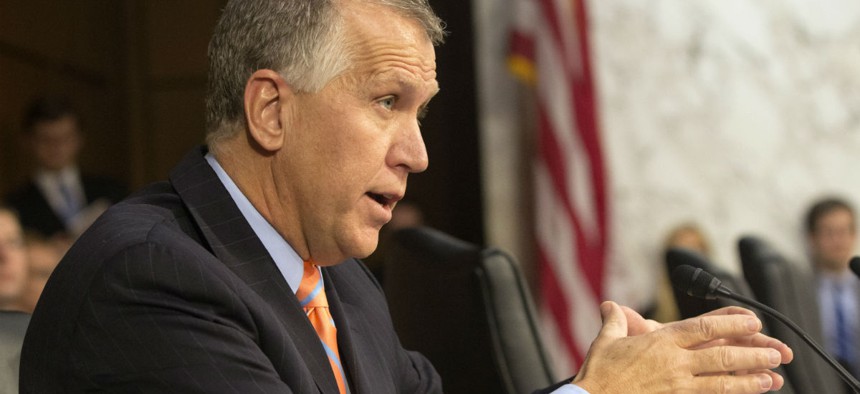
“We need to step back and instead of having hearings and chasing shiny objects, we start looking at the VA on a holistic basis,” said Sen. Thom Tillis, R-N.C. Jacquelyn Martin/AP
Senators Propose Acting as 'Board of Directors' for VA
Lawmakers lament lack of accountability; beleaguered undersecretary tells them she takes management problems seriously.
Senators from both parties threw skeptical questions at an interim Veterans Affairs Department undersecretary on Wednesday at a hearing exploring ways to get the controversy-plagued department off the Government Accountability Office’s list of high-risk government operations.
Acting as controversies continue over construction cost overruns at VA facilities and treatment of whistleblowers, Senate Veterans’ Affairs Committee Chairman Johnny Isakson, R-Ga., said the addition of VA to the high-risk list in February and subsequent unanswered GAO recommendations “are a symptom of a systemic problem. Much like the [scandal over falsified patient wait times] that erupted in Phoenix this time [last] year, the problem was not isolated to Phoenix but it was systemic in nature.”
Ranking member Richard Blumenthal, D-Conn., spoke of “deep-seated systematic problems” in accountability, information technology and allocation of priorities. “If someone fails to do his or her job, they should be fired,” he said, calling for “the same expectations for accountability” as in the military.
Fault-finding testimony from GAO and the VA inspector general’s office was met with respectful pleas for more time from a VA official, and the hearing ended with a plan for a bipartisan group of senators to play the role of “board of directors” and help VA focus by coming up with a long-term strategic plan to “get results.”
GAO health care analyst Debra Draper said the veterans health care system was added to the high-risk list due to ambiguous policies and inconsistent processes; inadequate oversight and accountability; information technology challenges (such as outdated systems that lack interoperability); inadequate training for VA staff; and unclear resource needs and allocation priorities. She said 100 past GAO recommendations have yet to be resolved.
VA’s health metrics “tend to be self-reporting data, with no verification, and when we go into facilities we find something different,” Draper said. “It’s not a very rigorous oversight and accountability process.”
Dr. John Daigh Jr., assistant VA inspector general for healthcare inspections, said in written testimony that the Veterans Health Administration “is at risk of not performing its mission as the result of several intersecting factors. VHA has several missions, and too often management decisions compromise the most important mission of providing veterans with quality health care. Leadership has too often compromised national VHA standards to meet short-term goals. The VHA’s internal processes are inefficient and make the conduct of routine business unnecessarily burdensome.”
Defending the department’s ongoing reforms was Dr. Carolyn Clancy, VHA’s interim undersecretary for health, who said, “The secretary and all leaders are thoroughly committed to solutions to remediate the risks,” and the department takes GAO’s list very seriously. She cited the strategic “road map to excellence” and new tools under the 2014 Veterans Access, Choice and Accountability Act. She mentioned a new organizational chart in which the Office of the Medical Inspector reports directly to the undersecretary, modernized electronic health records and a new Web platform that veterans can consult.
“The VA has the capacity to address the problems and has directed all senior leaders to identify resources in the budget to achieve strategic goals,” Clancy said.
“This review of our system is something that we welcome,” she added. “The bottom line is we plan to align budget and execution and empower employees to do the right thing every time. We look forward to building a stronger system for our veterans that will be the biggest transformation in a generation.”
Senators criticized Clancy for testimony that Sen. Dan Sullivan, R-Alaska, called “unfocused” and lacking clear priorities. (She agreed and offered to amend it, though she got Sullivan’s home state wrong in addressing him.) There are so many problems, added Sen. Joe Manchin, D-W.Va., “it feels like we’re piling on.”
Clancy said the highest priority changes were based on judging how quickly capabilities could be fixed and what poses “the highest risks to patients. It takes time to implement things across the VA system.”
Many of the department’s “business practices were designed 20 years ago when the facilities were seen as laboratories of innovation,” she added. “But the flip side of that is that is what we got inconsistent processes.”
Frustration at the VA’s reform pace came out in remarks from Sen. Thom Tillis, R-N.C., who praised the VA workers in his home state. “Most of the solutions are good things already going on in the VA,” he said.
Tillis then proposed that the committee approach the VA like the “board of directors” of a private company with national markets. “It is our fiduciary responsibility to voters to make sure we don’t become a disabler,” he said. “We need to step back and instead of having hearings and chasing shiny objects, we start looking at the VA on a holistic basis.” Senators need to “be embedded in an enterprise transformation strategy to address these problems over the long term,” he said. That means finding “very specific action threads and a strategic timeline to actually produce results,” he added.
Tillis asked whether a “member of the other side” would agree and appoint a committee members to help with such a project. Blumenthal agreed.







